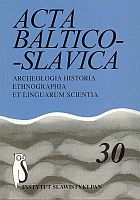До iсторiï одного прiзвища: Ейсмонт та Есимонтовський
To History of One Surname: Ейсмонт and Есимонтовський
Author(s): Maria VakulychSubject(s): Language and Literature Studies
Published by: Instytut Slawistyki Polskiej Akademii Nauk
Keywords: anthroponym; oykonym; connective vowel; Pluralia tantum; model with suffix
Summary/Abstract: Baltic antroponymy is widely spread on the territory which was the part of the Grand Lithuanian Duchy, especially in its Ukrainian part. This fact is confirmed by the memorial edition of the “Ukraine’s Book of Memory” which sets the lists of Ukrainian soldiers that were killed in 1941–1945. As there are no other large-scale antroponymical sources, it has become a powerful source of antroponymical findings. Having worked up the “Ukraine’s Book of Memory,” one finds out a region, where in the early 1900s the concentration of people with the Lithuanian surname Ejsmont was set (Zhytomyrs’ka Oblast’, Khmelnits’ka Oblast’). The author’s field investigations have shown that the modern antroponym is localized in the same territory (but native speakers take it as an Austrian or a Jewish one). Such zoning of the surname is interpreted as a result of migratory movement of impoverished Polish gentry in the 14th–16th centuries after Ukraine has become a part of Polish Commonwealth. Since the 17th century, along with Ejsmont, the documents set the family of Esymontows’ky, Cossack gentry of Chernihiv. The duality of the Baltic name, functioning on the East-Slavonic basis, illustrates the opposition of presence/absence of the connective vowel -i- in disyllabic Lithuanian antroponyms (Ejs-mont/ Es-i-montows’ky). K. Buga points out that oikonyms arising from dibasic surnames often function in plural. The realization of this model is traced in Lithuanian-Byelorussian boundary. It is confirmed by M. Fasmer and “Słownik geograficzny królestwa Polskiego”: village Ejsymonty Wielikie/ Ejsmonty Wielikie (Bogorodyts’ka Volost’ Grodnens’ky Povit), village Ejsymonty Malye/ Ejsmonty Malye (Maloberestovyts’ka Volost’ Grodnens’ky Povit), village Ejsymonty / Ejsymonty Nadtobolskie (Vertslyashkivs’ka Volost’ Grodnens’ky Povit). Compare with modern antroponyms: village Ejsmanty Wyalikiya (Berestovyts’ky Rayon Grodnens’ka Oblast’, Belorus’) and village Ejsmanty (Vertslyashkiws’ky Rayon Grodnens’ka Oblast’, Belorus’) (1982). Given proper nouns, as the surnames, spread in the Ukrainian territory, are the evidence of the process of loss of the connective vowel -i- (as possible method of onym’s shortening): at first, single falling out of the connective vowel and simultaneous functioning of both phonetic variations (Ejs-y-monty/ Ejs-monty), and subsequently, its disappearing. Furthermore, in word-formative context, the spatial modification of derivative structure of the proper name is traced. The family of Ejsymontows’ky had founded a village Symontowka (Mglynovs’ky Povit Chernyhivs’ka Guberniya, nowadays – Brans’ka Oblast’, Russia). In the course of time, it has consequently come into the line of Ukrainian derivational suffix antroponymical oykomyms: Domontowka (Skvirs’ky Povit Kyivs’ka Guberniya), Korbutowka (Zhytomyrs’ky Povit Volyns’ka Guberniya), Montwidowka (Kupyans’ky Povit Kharkivs’ka Guberniya), Gedrimowka (Odes’ky Povit Khersons’ka Geberniya).....
Journal: Acta Baltico Slavica
- Issue Year: 2006
- Issue No: 30
- Page Range: 291-299
- Page Count: 9
- Language: Ukrainian

